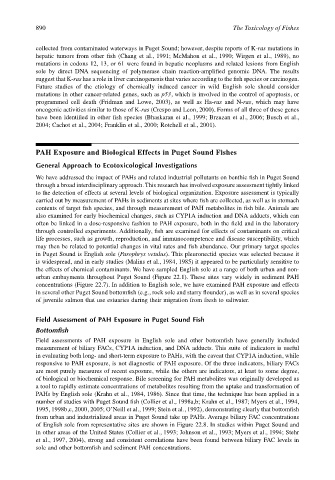Page 910 - The Toxicology of Fishes
P. 910
890 The Toxicology of Fishes
collected from contaminated waterways in Puget Sound; however, despite reports of K-ras mutations in
hepatic tumors from other fish (Chang et al., 1991; McMahon et al., 1990; Wirgen et al., 1989), no
mutations in codons 12, 13, or 61 were found in hepatic neoplasms and related lesions from English
sole by direct DNA sequencing of polymerase chain reaction-amplified genomic DNA. The results
suggest that K-ras has a role in liver carcinogenesis that varies according to the fish species or carcinogen.
Future studies of the etiology of chemically induced cancer in wild English sole should consider
mutations in other cancer-related genes, such as p53, which is involved in the control of apoptosis, or
programmed cell death (Fridman and Lowe, 2003), as well as Ha-ras and N-ras, which may have
oncogenic activities similar to those of K-ras (Crespo and Leon, 2000). Forms of all three of these genes
have been identified in other fish species (Bhaskaran et al., 1999; Brzuzan et al., 2006; Busch et al.,
2004; Cachot et al., 2004; Franklin et al., 2000; Rotchell et al., 2001).
PAH Exposure and Biological Effects in Puget Sound Fishes
General Approach to Ecotoxicological Investigations
We have addressed the impact of PAHs and related industrial pollutants on benthic fish in Puget Sound
through a broad interdisciplinary approach. This research has involved exposure assessment tightly linked
to the detection of effects at several levels of biological organization. Exposure assessment is typically
carried out by measurement of PAHs in sediments at sites where fish are collected, as well as in stomach
contents of target fish species, and through measurement of PAH metabolites in fish bile. Animals are
also examined for early biochemical changes, such as CYP1A induction and DNA adducts, which can
often be linked in a dose-responsive fashion to PAH exposure, both in the field and in the laboratory
through controlled experiments. Additionally, fish are examined for effects of contaminants on critical
life processes, such as growth, reproduction, and immunocompetence and disease susceptibility, which
may then be related to potential changes in vital rates and fish abundance. Our primary target species
in Puget Sound is English sole (Parophrys vetulus). This pleuronectid species was selected because it
is widespread, and in early studies (Malins et al., 1984, 1985) it appeared to be particularly sensitive to
the effects of chemical contaminants. We have sampled English sole at a range of both urban and non-
urban embayments throughout Puget Sound (Figure 22.1). These sites vary widely in sediment PAH
concentrations (Figure 22.7). In addition to English sole, we have examined PAH exposure and effects
in several other Puget Sound bottomfish (e.g., rock sole and starry flounder), as well as in several species
of juvenile salmon that use estuaries during their migration from fresh to saltwater.
Field Assessment of PAH Exposure in Puget Sound Fish
Bottomfish
Field assessments of PAH exposure in English sole and other bottomfish have generally included
measurement of biliary FACs, CYP1A induction, and DNA adducts. This suite of indicators is useful
in evaluating both long- and short-term exposure to PAHs, with the caveat that CYP1A induction, while
responsive to PAH exposure, is not diagnostic of PAH exposure. Of the three indicators, biliary FACs
are most purely measures of recent exposure, while the others are indicators, at least to some degree,
of biological or biochemical response. Bile screening for PAH metabolites was originally developed as
a tool to rapidly estimate concentrations of metabolites resulting from the uptake and transformation of
PAHs by English sole (Krahn et al., 1984, 1986). Since that time, the technique has been applied in a
number of studies with Puget Sound fish (Collier et al., 1998a,b; Krahn et al., 1987; Myers et al., 1994,
1995, 1998b,c, 2000, 2005; O’Neill et al., 1999; Stein et al., 1992), demonstrating clearly that bottomfish
from urban and industrialized areas in Puget Sound take up PAHs. Average biliary FAC concentrations
of English sole from representative sites are shown in Figure 22.8. In studies within Puget Sound and
in other areas of the United States (Collier et al., 1993; Johnson et al., 1993; Myers et al., 1994; Stehr
et al., 1997, 2004), strong and consistent correlations have been found between biliary FAC levels in
sole and other bottomfish and sediment PAH concentrations.

